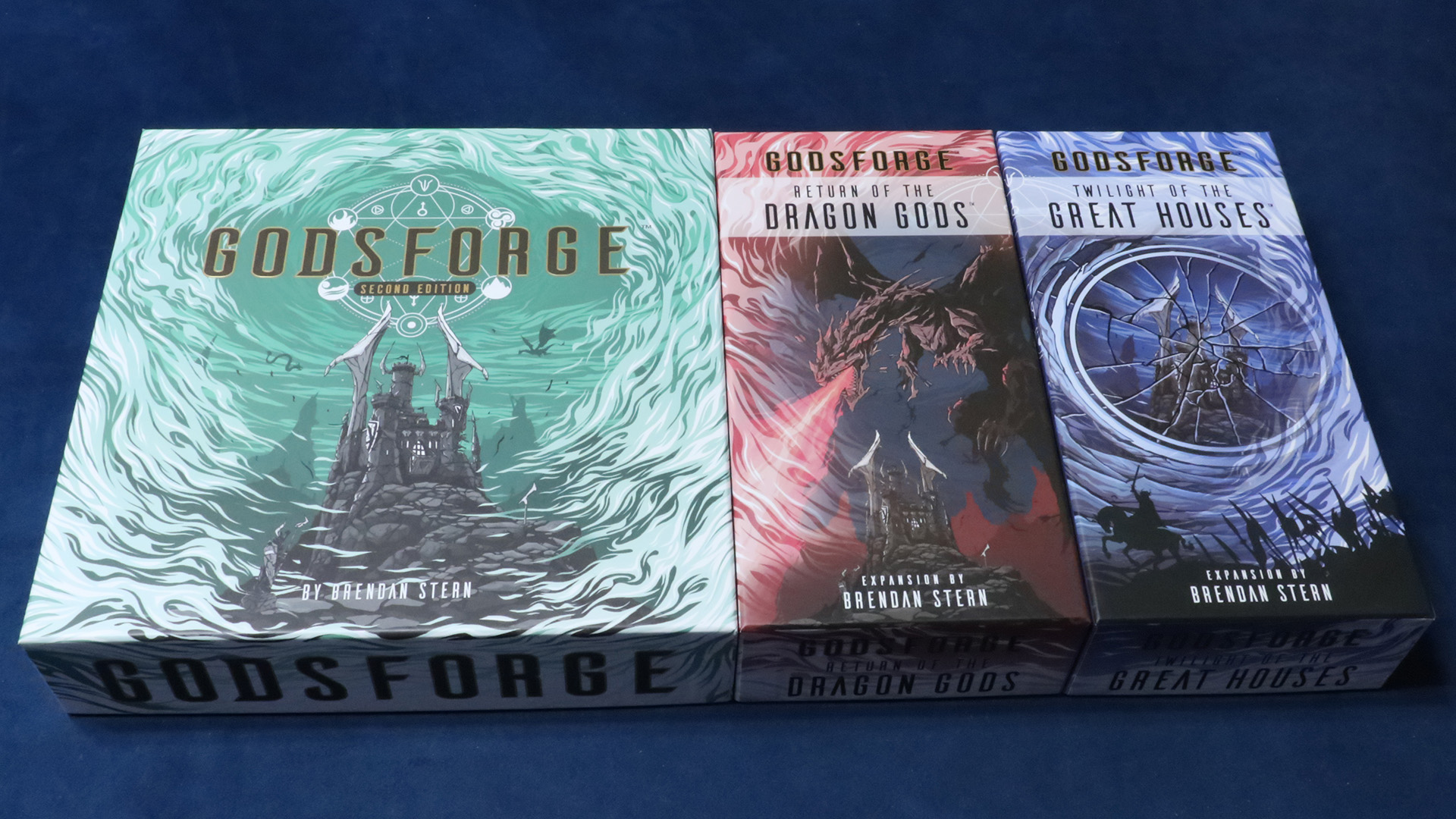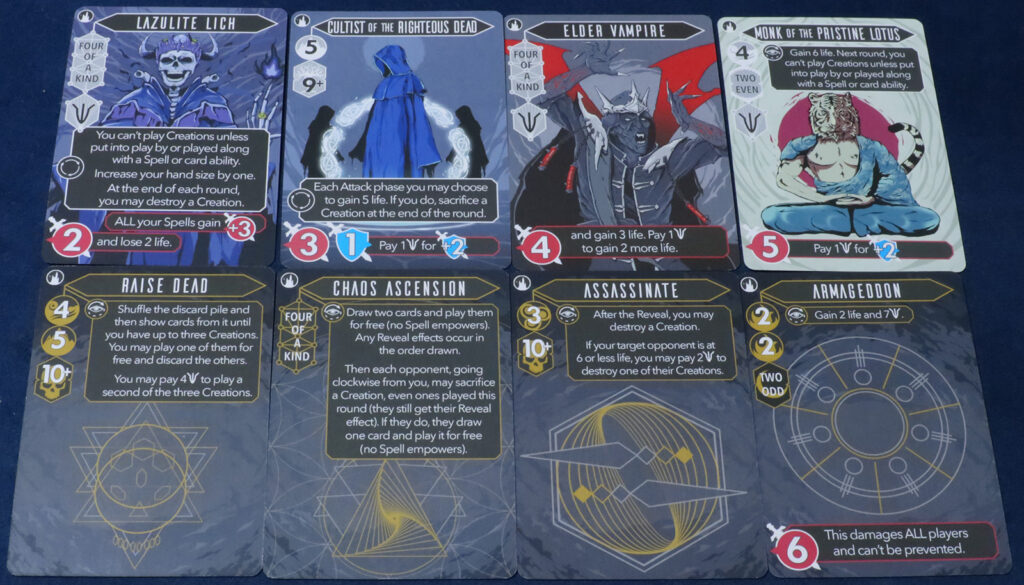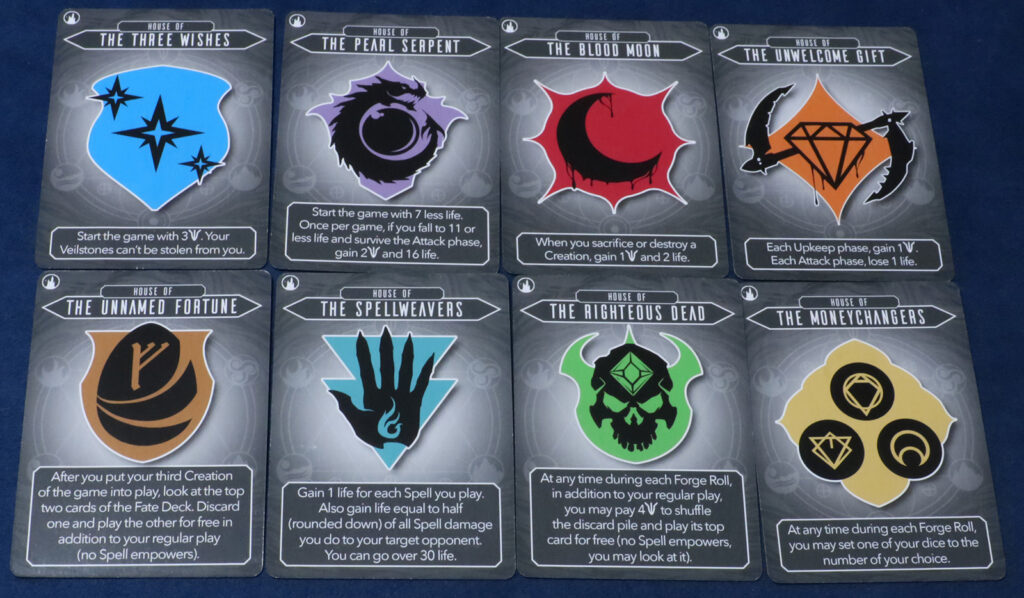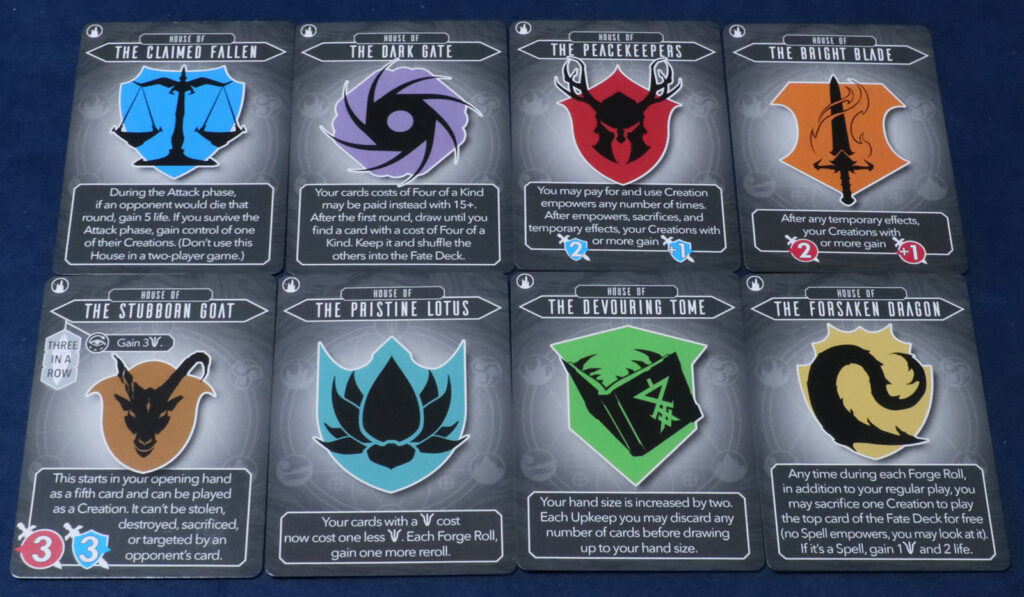While there are plenty of board games whose goal is to be the last person standing, the 1st edition of Godsforge did an excellent job of threading the needle of being both approachable from a rules perspective and strategically engaging while sprinkling in just the right amount of chaos.
This surprise find at Gen Con 2021 quickly won over our playgroup, and has been in regular rotation at our game table since. So when Atlas Games reached out to us and asked if we wanted a free copy of their new 2nd edition, complete with expansions, to try out and review, I naturally jumped at the opportunity.

Going into this review, I had two major questions:
- What did 2nd edition Godsforge change from 1st edition?
- What do the expansions (Return of the Dragon Gods and Twilight of the Great Houses) add to the game?
Without further ado, let’s dive in, find the answers, and see if they result in a better gameplay experience! If you’re unfamiliar with Godsforge and considering it for your collection, I recommend reading my 1st edition Godsforge review, complete with a quick rules walkthrough, to see if this game is right for you before proceeding.
For those who’d rather see the cards and components in a video, I’ve also uploaded an unboxing of Godsforge 2nd edition, complete with 1st edition comparisons to YouTube, which you can watch below.
Godsforge 2nd Edition Core Game Updates
Positive Changes
- The rulebook is much better organized, making it much easier to find answers to gameplay questions
- The cheat sheet cards have received a similar makeover to the rulebook, making it easier to follow phase actions (with one exception)
- Veilstones may be collected using unused Forge Roll dice that add up to 6
- The game box’s depth has been reduced by 3/4 of an inch, allowing it to take up less shelf space
- The box insert has been redesigned to work with 2nd edition’s new expansions
The 2nd edition of Godsforge keeps cards and gameplay the same while organizing its rules much more efficiently. Great care has been given to reduce an already low barrier to entry, making it easier than ever to pick up the game at a glance and start playing thanks to the cheat sheets.
My sole issue with this reorganization comes with one crucial omission on the cheat sheet – the ability to collect Veilstones during your Forge Roll. Going off the cheat sheet, you are told to collect these in the middle of the Reveal Phase, but the rulebook states you may use any you collect during the same Forge Roll as well – just like 1st edition.
This is extremely important when playing with the expansions – Veilstones are an extremely crucial resource for many of the new cards. That said, I also appreciate the new ability to use multiple unused Forge Roll dice that add up to 6 to snag a Veilstone because of this – as well as the fact that it was called out on the cheat sheet.
Finally, I hugely appreciate that Godsforge’s 2nd edition core box was designed with Return of the Dragon Gods and Twilight of the Great Houses in mind – everything from these three game boxes fits neatly in the core game’s insert so long as your cards are unsleeved.
The inserts for the cards are also wide enough to accommodate sleeves, but the reduced depth makes this impractical unless you use one of the expansion boxes to store components like dice and Veilstones. Definitely doable, but something you’ll want to keep in mind if you go this route.
Negative Changes
- The Veilstones have been changed from having a metallic look to a translucent yellow gem look
- The dice faces have been changed from normal dice faces
When all of my primary issues with a game’s update are limited to cosmetic changes, which are subjective in nature, you’re doing the important things right with your game. I touched on these changes when I unboxed the 2nd edition of Godsforge for our YouTube channel, and now that I’ve played with these updated components, my thoughts haven’t really changed.
The look of the Veilstones is a notable step down. In addition to them not looking as good on camera, it’s harder to tell how many you have at a glance if they’re in a pile. Further, they just don’t feel as aesthetically special or important to me, taking away from the immersion of being a wizard who is fighting for them.

2nd edition’s dice are also just straight up harder to read. My vision is admittedly not great, but I can usually tell what I’ve rolled at a glance, even at a distance, on normal d6s.
I mixed up 4 and 5 a lot during our gameplay stream with Godsforge’s redesigned dice, and while the new 1 and 6 designs are supposed to clue you in to their importance (wilds and Veilstone acquisition, respectively), neither was flattering in terms of design and both were ultimately distracting.

Despite these relatively minor complaints, I consider 2nd edition’s changes to be overwhelmingly positive. That said, if you already have a 1st edition copy of the core game, I see no need to buy the 2nd edition version. There’s simply nothing of substance that has changed in terms of the components, and the new rules can easily applied to either game.
The expansions, on the other hand? Well, if you liked what I outlined above, you’ll probably love what they bring to the table! And yes, they too are compatible with 1st edition.
Godsforge’s 2nd Edition Expansions and New Mechanics
Return of the Dragon Gods
Return of the Dragon Gods has 3 new mechanics it introduces to Godsforge’s gameplay:
- Upgrade Cards: Creations with this mechanic may have a Veilstone placed upon them when revealed and on each Upkeep. They gain the listed Upgrade benefit for each Veilstone placed upon them.
- Card Synergy: These cards grant benefits for each type of a specific card you have in play, such as Golems or Dragons. Refer to the names of your Creations to determine what type(s) of card they are.
- +1 Player: Each expansion allows you to add an additional player to the game. 5 and 6 player games have each player start at 20 life.
Having gotten a few games under my belt now, I would say this expansion’s Upgrade Cards are the clear winner in terms of gameplay impact. Upgraded Creations can leave you feeling like you’re facing an inexorable tide if they’re left unchecked, so dealing with them quickly is an absolute must.

Fortunately, several of the new cards in this expansion come with the ability to destroy Creations, so you’ve got a good chance of digging through the deck for an out if you find yourself staring one down without a piece of removal in your hand.

Overall, the cards focused around Card Synergy didn’t feel especially impactful. That felt weird to write, so I actually went back and looked at the deck to make sure I didn’t miss something. Turns out I didn’t – there were only a couple cards with the mechanic!
This actually makes a lot of sense to me though. Godsforge’s original deck was not designed with tribal synergy in mind. Trying to shoehorn it in after the fact would likely lead to a lot of lackluster cards without some major support that let you dig for the creatures you needed to make them work from the deck or discard pile.
I’m just as glad the developers for this expansion figured that out as well, and the end result is simply better for it. I wouldn’t mind seeing the occasional support card show up in the future though – promo opportunities or even 3rd edition perhaps? Time will tell.
Twilight of the Great Houses
Twilight of the Great Houses was easily my favorite of these two expansions, and it’s not close. The new mechanics it brings to the table are:
- Great Houses: Choose an ability from either side of a double-sided Great House card (you may look at your hand first). You gain that house’s ability. Each player starts with 5 extra life.
- Lose Life cards: These cards reduce a target’s life total like normal damage cards, but damage prevention effects may not be used on them.
- Cannot Play Creations: Cards that inflict this effect require you to use a spell or ability to put a creature into play – you may not craft these via your Forge Roll as normal.
- +1 Player: Each expansion allows you to add an additional player to the game. 5 and 6 player games have each player start at 20 life.
The Great Houses are EXACTLY what Godsforge needed to up its strategy a notch. At the risk of gushing, I absolutely adored this mechanic when we played with it, as it opened up some truly spectacular gameplay possibilities.
You don’t have to take my word for it though – check out the Great Houses below (click or tap the images to enlarge)!
Nearly all of these will play well in a small or large game (The Claimed Fallen being a notable exception in games of 3 or fewer players), and they can dramatically change your perspective when deciding which cards will be best for your strategy.
While my overall favorite house I got to play was The Stubborn Goat (that card is seriously no joke), my favorite game was with a combination of the Dark Gate and the Lazulite Lich, fueled by a hand full of creation destroy spells to hold a vice grip over the game.

For extra chaos, the Great Houses also come with a couple variant rulesets. The “Shared House” rules allow 2 players to use separate sides of the same double sided card, allowing special abilities that wouldn’t normally be seen in the same game to show up together.
The “Allied Houses” rules are even crazier, giving each player 2 houses instead of one to work with. Considering how much of an impact 1 house can have on gameplay, bumping everyone’s starting life total to 35 or 40 as suggested not only feels fair, it feels necessary.
As with Return of the Dragon Gods, the other gameplay mechanics had a very limited impact on our games. The lone exception was a Chaos Ascension that put a Monk of the Pristine Lotus onto my field. Despite discarding my entire hand, I still drew an all Creation hand, and had to take the 4 Veilstones.
For the first time ever, this actually ended up saving me, as I was able to fuel a massive defense that left me alive at 1 life while Phil succumbed to my Creations and the 7 damage caused by Callahan’s death. So major props to the designers for adding cards to the game that make what felt like a backbreaking setback into a viable move.
Godsforge Expansions Review

The Meeples’ overall first impression was that the new expansions are powerful. There are very few duds within these new spells and creations, particularly compared to the core deck, which has a lot of mediocre, overcosted cards that frequently rot in hands or get discarded.
We’d even go so far as to say the new cards make everything so unbalanced it actually acts a balancing mechanism – which is honestly how a slug it out duel between a group of desperate, power hungry wizards should feel.
It’s no longer about whose crafted rock sphinxes and trinkets let you scrape together the most small advantages – calling forth Armageddon itself is fair game if it means getting what you want. Nothing feels off-limits, and that in turn makes preparation and reading your opponents super important from turn to turn.
Veilstones are also infinitely more important with the expansions in play. They’re all over the costs for spells, Creations, and abilities, so securing an early stockpile is huge. To say nothing of some of the spells that let you just dump a pile of Veilstones into them for extra damage to strike a killing blow.
Games also start on much more even footing than they used to with the optional “Draw 10, Keep 4” rule. Everyone gets to look at 10 cards, construct an opening hand of 4 from them, and shuffles the rest back into the deck. These choices can also be agonizing, as you’ll often be presented with several powerful cards and strategies to choose from.
Finally, I love that the expansions open gameplay up to 6 players. This is the type of game that feeds on chaos, and the best way to add more of that in is by getting more of your friends around the table! Since turns take place at the same time, this also doesn’t slow gameplay much compared to a 4-player game, which is a major plus.
There’s also a solo Godsforge variant, which is a great way to either pass a quiet afternoon or get in some practice against cards and strategies you struggle with during regular games. Either way, this is also a neat option for expanding this game’s utility, even if I personally don’t see myself using it a lot.
Overall, I think the expansions do an excellent job of removing the staleness the core game can find itself with over time, adding just enough strategy to keep you on your toes while still being light enough I can lose track of 3 hours engaging my fellow wizards in mortal combat.
In fact, we did exactly that on a stream!
If you liked the base game, Return of the Dragon Gods and Twilight of the Great Houses are a must pick-up. If you haven’t tried Godsforge just yet, give the base game a try before going all-in – though if your group likes chaotic, competitive games, this is a safe and inexpensive one to invest in the expansions for from the jump.
Other Board Game Articles You May Like
- Godsforge Board Game Rules Walkthrough
- Splendor Strategy Guide
- Smash Up Best Expansions
- Games Better Than Risk
- 7 Wonders Strategy
- Games Like Clue
Braden is a founder of Assorted Meeples and has been a gamer & writer with a vivid imagination all his life. Don’t believe us? Check out his excitement when meeting Goosebumps author R.L. Stine as a kid! An avid Magic: The Gathering spellslinger for over 15 years, you can always convince him to shuffle up for a game (or three!) of Commander.


